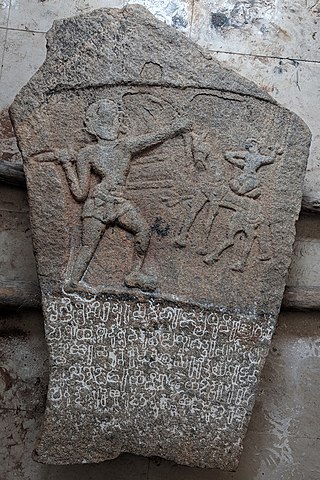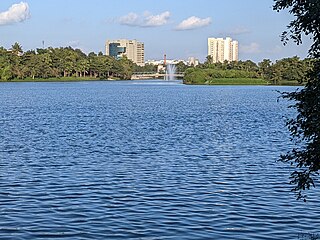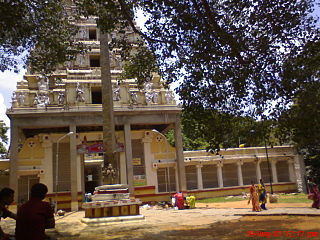
Devanagari is an Indic script used in the northern Indian subcontinent. Also simply called Nāgari, it is a left-to-right abugida, based on the ancient Brāhmi script. It is one of the official scripts of the Republic of India and Nepal. It was developed and in regular use by the 7th century CE and achieved its modern form by 1000 CE. The Devanāgari script, composed of 48 primary characters, including 14 vowels and 34 consonants, is the fourth most widely adopted writing system in the world, being used for over 120 languages.

Magadi is a town and taluk located in Ramanagara district, Karnataka, India.

The Bhattiprolu script is a variant of the Brahmi script which has been found in old inscriptions at Bhattiprolu, a small village in the erstwhile Guntur district of Andhra Pradesh, India. It is located in the fertile Krishna river delta and the estuary region where the river meets the Bay of Bengal.

The Minor Inscriptions of Kharavela are the shorter inscriptions found near the major and celebrated Hathigumpha inscription of Kharavela in the twin hills of Udayagiri and Khandagiri Caves near Bhubanesvar, Odisha, India. These are inscribed on the walls or front of the caves in Brāhmī script and Prakrit language. They were published and deciphered by R. D. Banerji during the years 1915–16. Others such as B. M Barua have also published their comments on these. These minor inscriptions mention the construction of caves for Jain monks during or during the decades following the reign of Kharavela.
Gulakamale is a village in Bangalore district, Karnataka, India, near Kaggalipura on Bangalore – Kanakapura Road. The population of the village is 2,293 which made up of 1,131 males and 1,162 females. The literacy rate is lower than that of Karnataka and stands at 71.82% as opposed to 75.36% of the rest of the state. Out of those who are literate are 81.05% male and 62.70% female populations. Scheduled Castes and Tribes make up 51.72% and 0.22% respectively.
Kalya (Kalavathi pattana) or Kalya is a historic settlement located in Magadi Taluk, Ramanagara district of Karnataka, India. Kalya as an early settlement can be attested by the fact that the prehistoric rock art and tools reported from Kalya,and also inscriptional documentation in the village from 550 CE to the early 17th century CE, making it one of the few places in the country that has been continuously inhabited for 3000 to 3500 years.

About 25,000 inscriptions found in Karnataka and nearby states belong to historic Kannada rulers, including the Kadambas, the Western Ganga Dynasty, the Rashtrakuta, the Chalukya, the Hoysala and the Vijayanagara Empire. Many inscriptions related to Jainism have been unearthed. The inscriptions found are generally on stone (Shilashasana) or copper plates (Tamarashasana). These Kannada inscriptions are found on historical hero stones, coins, temple walls, pillars, tablets and rock edicts. They have contributed towards Kannada literature and helped to classify the eras of Proto Kannada, Pre Old Kannada, Old Kannada, Middle Kannada and New Kannada. Inscriptions depict the culture, tradition and prosperity of their era. The literature of Ramayana and Mahabharata are transferred through the generations by these inscriptions. The Hazara Rama Temple and Aranmula Parthasarathy Temple are the best examples of temples associated with Kannada inscriptions.

The Hebbal-Kittayya 750CE Inscription is one of the oldest known inscriptions in Kannada script and is Bangalore's oldest inscription. The inscription was re-discovered on 1 May 2018 in Hebbal. The inscription is on a Ooralivu Veeragallu in honour of Hebbal native Kittayya. Ooralivu veeragallu’s are memorial stones erected in honour of a person martyred defending an attack on his or her town.
Jakkur is a suburb in the northern part of Bangalore, Karnataka, India. Located on the eastern side of the National Highway 44 between Yelahanka and Hebbal. Primarily a residential locality the area is also known for the Jakkur Aerodrome ,Jakkur lake, and Jawaharlal Nehru Centre for Advanced Scientific Research. Jakkur Aerodrome spread over 200 acres, opened in 1948 is now a pilot training school.

Gulakamale is located in Bangalore South taluk of Bangalore district in Karnataka, India. Two inscriptions are found in Gulakamale of which one is a donation inscription, and the other, a Mahasati herostone, a typology of herostones dedicated to women who self-sacrificed in sati. Additionally, two other hero stones are also found at the same place.Gulakamale is also famous for its lake, a birding hotspot on the city's outskirts.

Malleshwaram is a North-Western locality of Bengaluru and one of the oldest planned layouts of Bengaluru. In 1898 when Bangalore was hit by the plague epidemic, Malleshwaram was developed on modern lines as a new residential locality of the city. However, as evidenced by Ekoji's inscription the village of Mallapura had existed since at least 1669CE. The name Mallapura is derived from two words, Malai meaning "hill" and Pura meaning "town". The name Mallapura has since changed to Malleshwara over the years.
Ivara Kandapura is a small hamlet adjoining Hesaraghatta on the northern outskirts of Bangalore, in Karnataka, India. Ivara Kandapura is famous for a 10th-century temple complex that is home to five temples, named after the pandavas as The Dharmeshwara, Nakuleshwara, Bheemeshwara, Sahadeshwara, Arjuneshwara and Kunti Gudi.

Domlur is a locality in the eastern part of Bengaluru city in India. Domlur is a historic places as indicated in the 18 inscriptions spanning the period 1200-1440CE found there. Of these, 16 inscriptions are at the Chokkanathaswamy Temple dedicated to the deity Chokkanathaswamy or the Chokka Perumal [the Hindu God Vishnu]. Of these eleven inscriptions are from the period 1200-1440 CE and have been documented earlier in Epigraphia Carnatica, Vol 9, these are mostly donatory inscriptions for the deity Chokkanathaswamy and for the Someshwara temple (non-existent).

Singapura is a locality in the northwestern part of Bengaluru, Karnataka, India. The Varadarajaswamy Temple in Singapura is at least 500 years old, as recorded in Harohalli and Chikkabettahalli inscriptions. The temple is referred to as the Tiruvengalanatha temple in inscriptions. The inscriptions also mention a grant given to Ramanuja Koota, a religious institution of Sri Vaishnavites, named after the reformer-saint Ramanuja.

Jakkur, a suburb in Bengaluru is an old locality that has an historicity of about 700 years. The locality is home to four inscriptions and several hero stones. The earliest inscriptions of the area can be paleographically dated to 9th - 10th century CE. These inscriptions also indicate that Jakkur Lake, regarded as one of the biggest lakes of Bangalore, existed as old as seven centuries ago.

Allalasandra is a historic locality in North Bengaluru adjoining the Gandhi Krishi Vigyan Kendra (GKVK) campus on Bellary road. Allasandra's historicity tracing back to about 500 years can be attested from the Rachur Narasappiah's Donation Inscription mentions the donation of the entire village of Allalasandra to the Allalanatha temple at Jakkur.
Bileshivale is a historic locality in Bengaluru. An inscription at Bileshivale is being documented here for the first time. It documents existence of a temple in the 14th century at Bileshivale, the location of which cannot be ascertained. This inscription shows that Kalkere, the lake and the place are at least 700 years old.

It is a Kannada inscription paleographically dated to the 15th century CE, discovered by the Mythic Society Bengaluru Inscriptions 3D Digital Conservation Project team in April 2022 in the Anjaneya Temple,Anjanapura. Much information cannot be contextualized as the text is effaced but appears to be a donatory inscription. The typical character size of the Inscription is 4.9 cm tall, 7.1 cm wide and 0.15 cm deep.

The Basavanagudi Inscriptions are a set of three Kannada and one Tamil inscriptions that can be found in the locality of Basavanagudi. Of the four, three Kannada inscriptions are physically present and the fourth Tamil inscription's physical status remains unknown. The available Kannada inscriptions can be found in Bugle rock park and Dodda Basavana Gudi or Big bull temple. Two inscriptions found in the vicinity of Dodda Basavana Gudi or Big bull temple, both describe the Vrishabhavati river's origin as coming from the feet of the Basava idol in the temple's sanctum and flowing westwards thereon as Paschimavahini. The two inscriptions can be found: one on the pedestal of the Basava deity in the sanctum and the other on a boulder in the shrubbery surrounding the temple. Two more inscriptions that are published, one is a one line Tamil inscription in Grantha script published in Epigraphia Carnatica and is about possible donatory inscription to the Chokkanathaswamy Temple in Domlur, a locality in Bengaluru, its physical status is not known at present and the other is a one line Kannada inscription in the Kannada script published in Itihasa Darshana Journal and is present on a boulder in the Bugle rock park in Basavanagudi is about one Deevatige Soma.
Marasuru Madivala is a village in Anekal Taluk of Bengaluru, in the Indian state of Karnataka. It is a historical settlement with a history of over a millennium, its significance lies in the discovery of an herostone-inscription and an ornate sculpture of Chamundi found in the village which is currently housed in a new mantapa. It is home to a 10th-century Someshwara temple, and a modern-day Nandi mantapa restored with 8th-century Ganga style stone pillars, Sati stones, hero-stones and a few ancient Jaina idols.






















